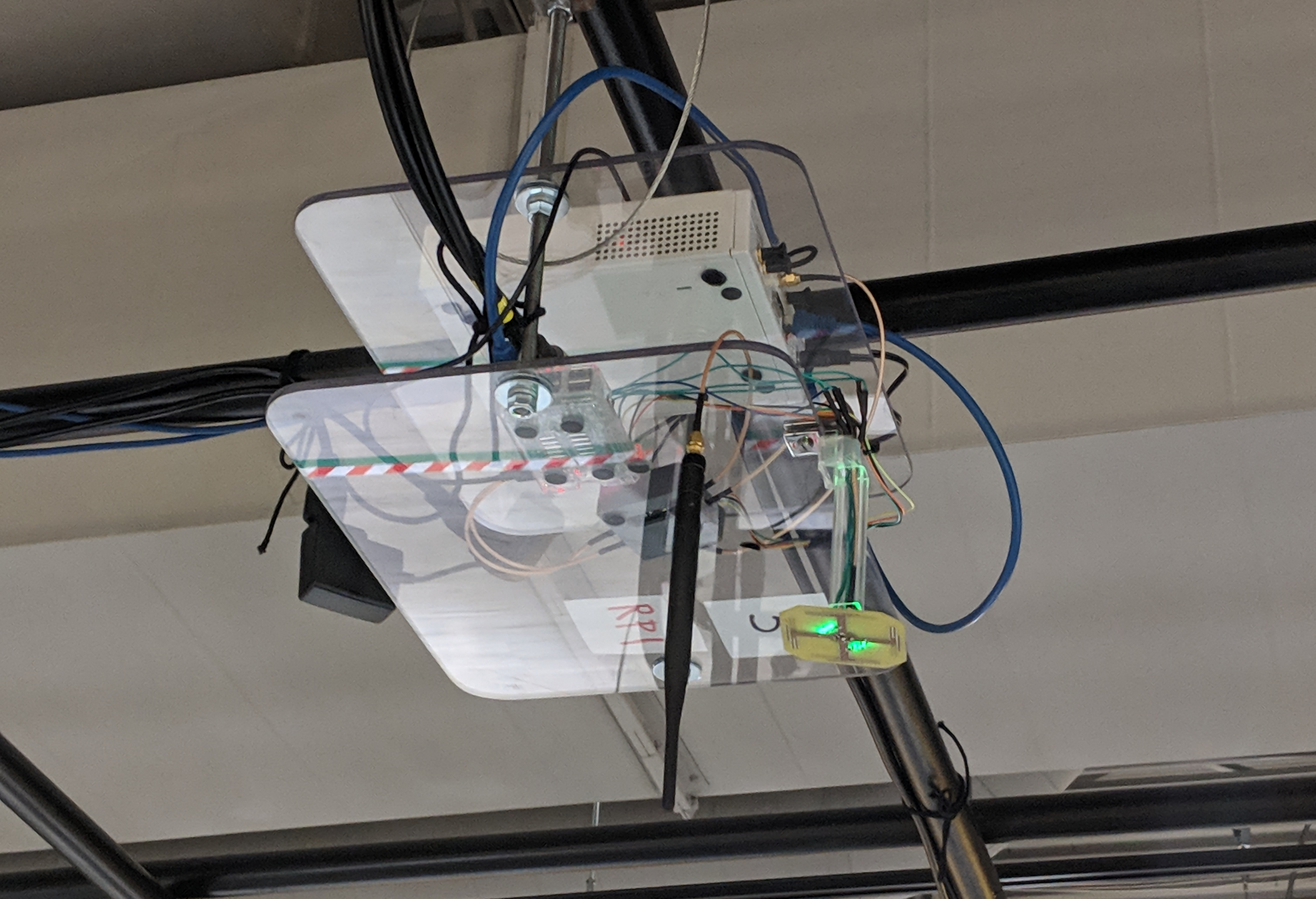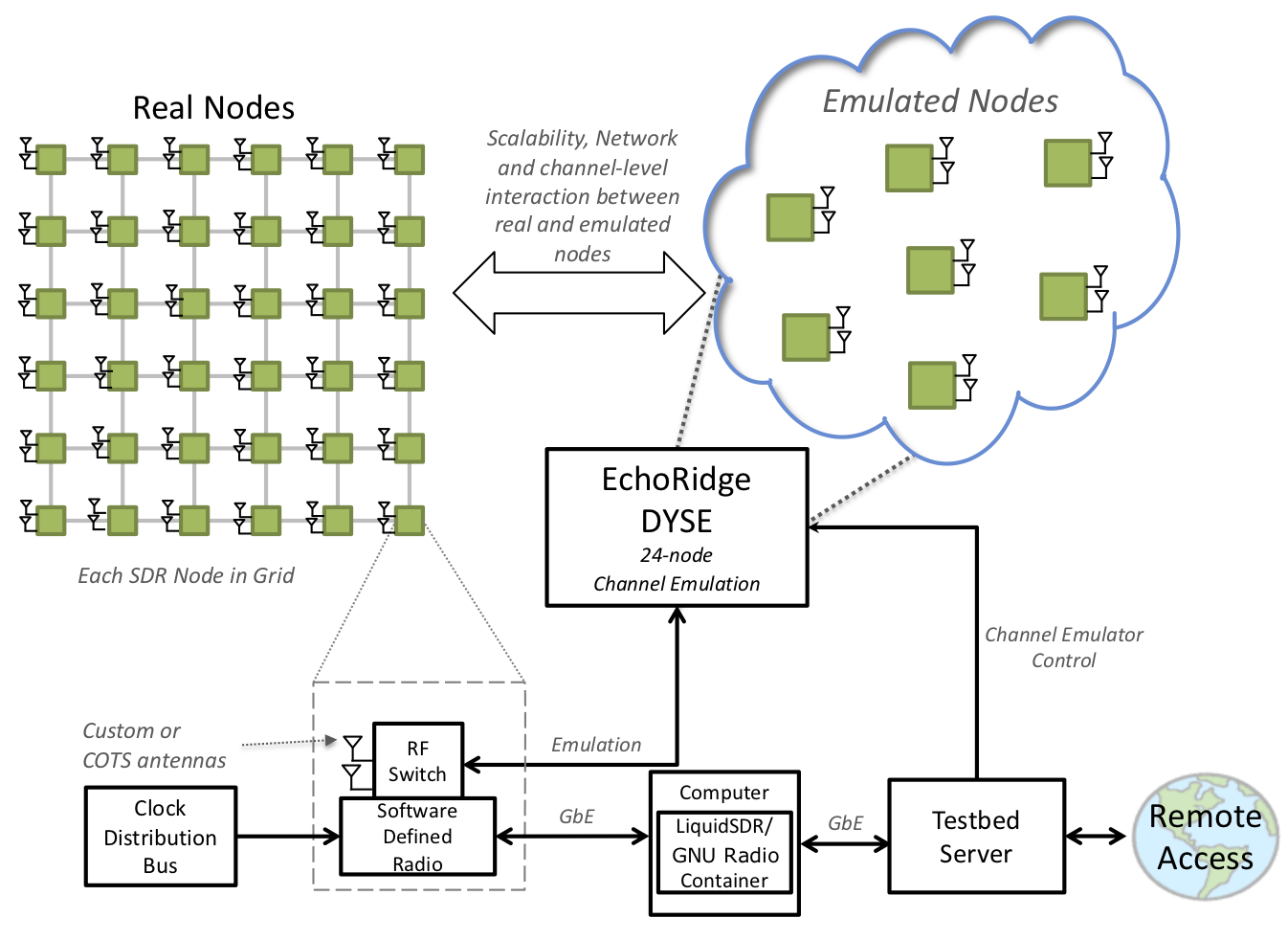Lab Drexel Grid SDR Testbed
NSF CNS Award #1730140 II-NEW: Scalable Software Defined Radio Network Testbed for Hybrid Measurement and Emulation
Reporting Period: 08/1/17-07/31/2022
Personnel
PI: Kapil R. Dandekar
Co-PI: Geoffrey Mainland
Co-PI: Baris Taskin
Co-PI: Steven Weber
Post-doc: Vasil Pano
Graduate Students:
Abhinanda Dutta
Marko Jacovic
Jahan Alex Lackpour
Hariharan Narayan
Xaime Rivas Rey
Md Abu Saleh Tajin
Undergraduate Students
Adeeb Abbas
Abhishek Adhikari
Sujoy Das
Sameer Parihar
Industrial Collaborators
Lockheed Martin Advanced Technology Labs
John Hopkins Applied Physics Lab
Goals
Given the difficulties associated with field testing of wireless communication systems in diverse environments, it would be beneficial to have a testbed that can expose real radio hardware to realistic indoor and outdoor wireless channels in a controllable and repeatable manner. To address these challenges, we are building the Drexel Grid SDR Testbed. This testbed is a unified experimental framework to rapidly prototype and evaluate a diverse range of wireless systems using: i.) field measurements to evaluate real time transceiver and channel-specific effects and ii.) network emulation to evaluate systems at a large scale with controllable and repeatable propagation channels. The hardware of the Drexel Grid SDR testbed consists of: i.) the Echo Ridge DYSE 24 port network channel emulator for multi-link emulation as well as hybrid measurement and simulation, ii.) a centralized server for experiment management hosting linux containers for each of the nodes in the grid, iii.) serveral dozen N210/X310 NI software defined radios (SDRs) deployed in a ceiling based network for over the air (OTA) testing (using omni-directional or reconfigurable directional antennas) or adaptive network and channel emulation, and iv.) a wired network for routing RF, timing, and control signals to nodes for automated experimentation with the testbed.

Complementing this hardware infrastructure is a software infrastructure composed of i.) an API with a custom built experimenter interface for reserving nodes and controlling the wireless channel emulator for both over the air and emulated experiments, and ii.) an LXC container based system for deploying SDR software supporting either GNU Radio or a custom full radio protocol stack that we have developed for cross layer prototyping and experimentation.
Intellectual merit
Major Goal #1: Flexible, real-time prototyping
Many SDR platforms in the industrial and academic research community are focused on relatively small variations of existing standards. The Drexel Grid SDR Testbed builds upon our work in developing a real-time, cross-layer, full radio stack software implementation, along with our experience in developing new antenna technologies for wireless communication systems. This flexibility, and potential for cross-layer integration, will be essential to consider a diverse set of applications including cybersecurity, cyberphysical systems, smart cities, and the Internet of Things without the constraints imposed by commercial standards.
Major Goal #2: Repeatable and customizable channels
Many existing wireless testbeds do not have real-time customizable and repeatable physical layer propagation channels. We are using the EchoRidge DYSE channel emulator to create customizable and repeatable channels using industry-standard and custom channel models while also enabling OTA testing in an indoor office environment with novel antenna technologies that provide broadband and directional radiation pattern capabilities. Furthermore, we have developed a software layer to allow site-specific electromagnetic ray tracing to provide the far-field channels encountered by the radio and have demonstrated how this can be used for site specific emulation for applications like UAV air-to-air and air-to-ground communication channels.

Applications
The Drexel Grid SDR testbed has been used for a wide variety of applications, including: radio frequency machine learning, cognitive radio, reconfigurable antenna evaluation, cybersecurity, medical RFID IoT, radar channel emulation, and electronic warfare.
Availability
The Drexel Grid SDR testbed is being used for a wide variety of research and educational projects at Drexel University, and uses a container structure similar to that used by the DARPA Spectrum Challenge Colosseum. We will make our testbed available to external users to allow them to run experiments such as i.) deploying radio containers with the ability to adjust the wireless channel between nodes and ii.) evaluation of custom antenna technologies with our customizable full stack software defined radio network. If you are interested in discussing potential research collaboration using the testbed in these or other areas, please contact us.
Details regarding the ongoing visualization and AR efforts to improve the accessibility of the Drexel SDR testbed can be found here.
For internal Drexel users, you may access the testbed and training materials here. Note that you must be connected to the campus VPN to access this site.
Broader Impacts
Wireless technologies have become ubiquitous and there is an ever growing number of devices around us that are gaining wireless networking capabilities. While this has resulted in increased adoption of wireless technologies, several new challenges have risen. Some of these challenges include security, connectivity in dense deployments, compatibility and longevity. A major issue with the investigation of these challenges is that a majority of wireless research is done by simulating simplified radio systems.
The DWSL Grid SDR testbed has been conceived to allow easy access to software defined radios and provide an ecosystem for SDR based radio prototyping. This testbed will enable the use of SDRs for unique and innovative wireless network experimentation. The Drexel Grid SDR testbed has the potential to impact research on a wide range of applications including with the Internet of Things (IoT), smart cities, and drones.
There are three components of human resource development being provided by the testbed:
Training students in testbed development - There is a significant amount of hardware and software development required for the Grid SDR testbed. Students are involved in all aspects of this work from developing the control and automation software required to implement the testbed, to deploying and characterizing the radio frequency cables, splitters, and transceivers required to integrate the system. These tasks provide solid training to create a new generation of radio and networking experts.
Educational uses of the testbed - The testbed has been leveraged for numerous undergraduate and graduate courses pertaining to analog and digital communication, wireless network security, and collaborative intelligent radio network design. We have also incresasingly used the testbed to engage undergraduate researchers in experiential education projects through the Drexel Vertically Integrated Projects (VIP) program. This exposure to hardware implementation provides valuable experience that cannot be obtained through theory and simulation alone.
Research uses of the testbed - The testbed provides an experimental capability to prototype network topologies using traditional and non-traditional antenna technologies. Furthermore, through the full radio stack protocol software implementation that we have developed, researchers have the ability to tweak parameters across all layers of the protocol stack.
Publications
Tajin, Md Abu and Jacovic, Marko and Dion, Genevieve and Mongan, William M. and Dandekar, Kapil R. (2021). UHF RFID Channel Emulation Testbed for Wireless IoT Systems. IEEE Access. 1 to 1. Published. 2169-3536. https://doi.org/10.1109/ACCESS.2021.3077845.
Rey, Xaime Rivas and Mainland, Geoffrey and Dandekar, Kapil. (2020). Real-time Online Learning for Pattern Reconfigurable Antenna State Selection. 2020 7th NAFOSTED Conference on Information and Computer Science (NICS). 13 to 18.
Rivas Rey, Xaime and Halpin, Thomas and Hadgekar, Shantanu and Miu, Karen and Dandekar, Kapil R. (2018). Cybersecurity Analysis of an IEEE 802.15.4 based Wireless Sensor Network for Smart Grid Power Monitoring on a Naval Vessel. ASNE Technology, Systems and Ships 2018.
Rivas Rey, Xaime and Halpin, Thomas and Hadgekar, Shantanu and Miu, Karen and Dandekar, Kapil R. (2018). Cybersecurity Analysis of an IEEE 802.15.4 based Wireless Sensor Network for Smart Grid Power Monitoring on a Naval Vessel. ASNE Technology Systems and Ships (TSS).
Rivas Rey, Xaime and Mainland, Geoffrey and Dandekar, Kapil (2020). Real-time Online Learning for Pattern Reconfigurable Antenna State Selection. 2020 7th NAFOSTED Conference on Information and Computer Science (NICS). 13 to 18. Published. https://doi.org/10.1109/NICS51282.2020.9335872.
Rivas Rey, Xaime and Halpin, Thomas J. and Hadgekar, Shantanu and Miu, Karen and Dandekar, Kapil R. (2018). Cybersecurity Analysis of an IEEE 802.15.4 Based Wireless Sensor Network for Smart Grid Power Monitoring on a Naval Vessel. 130. (3). Naval engineers journal, 130. 137-144.
Liston, Michael and Dandekar, Kapil R. (2020). Entropy Based Exploration in Cognitive Radio Networks using Deep Reinforcement Learning for Dynamic Spectrum Access. 2020 IEEE 21st Annual Wireless and Microwave Technology Conference (WAMICON) (WAMICON 2020).
Lackpour, Alex and Rey, Xaime Rivas and Mainland, Geoffrey and Dandekar, Kapil R. (2020). Greedy Channel Selection for Dynamic Spectrum Access Radios. 2020 IEEE International Symposium on Circuits and Systems. 1 to 4. Published. https://doi.org/10.1109/ISCAS45731.2020.9180882.
Jacovic, Marko and Juretus, Kyle and Kandasamy, Nagarajan and Savidis, Ioannis and Dandekar, Kapil R. (2020). Physical Layer Encryption for Wireless OFDM Communication Systems. Journal of Hardware and Systems Security. Published. 2509-3428. 10.1007/s41635-020-00097-8.
Dandekar, Kapil R. and Begashaw, Simon and Jacovic, Marko and Lackpour, Alex and Rasheed, Ilhaan and Rey, Xaime Rivas and Sahin, Cem and Shaher, Sharif and Mainland, Geoffrey (2019). Grid Software Defined Radio Network Testbed for Hybrid Measurement and Emulation. 2019 16th Annual IEEE International Conference on Sensing, Communication, and Networking (SECON) (SECON 2019). 1 to 9. Published. 10.1109/SAHCN.2019.8824901.
Chacko, James and Juretus, Kyle and Jacovic, Marko and Sahin, Cem and Kandasamy, Nagarajan and Savidis, Ioannis and Dandekar, Kapil R. (2019). Securing Wireless Communication via Hardware-Based Packet Obfuscation. Journal of Hardware and Systems Security. Published. 2509-3428. 10.1007/s41635-019-00070-0.